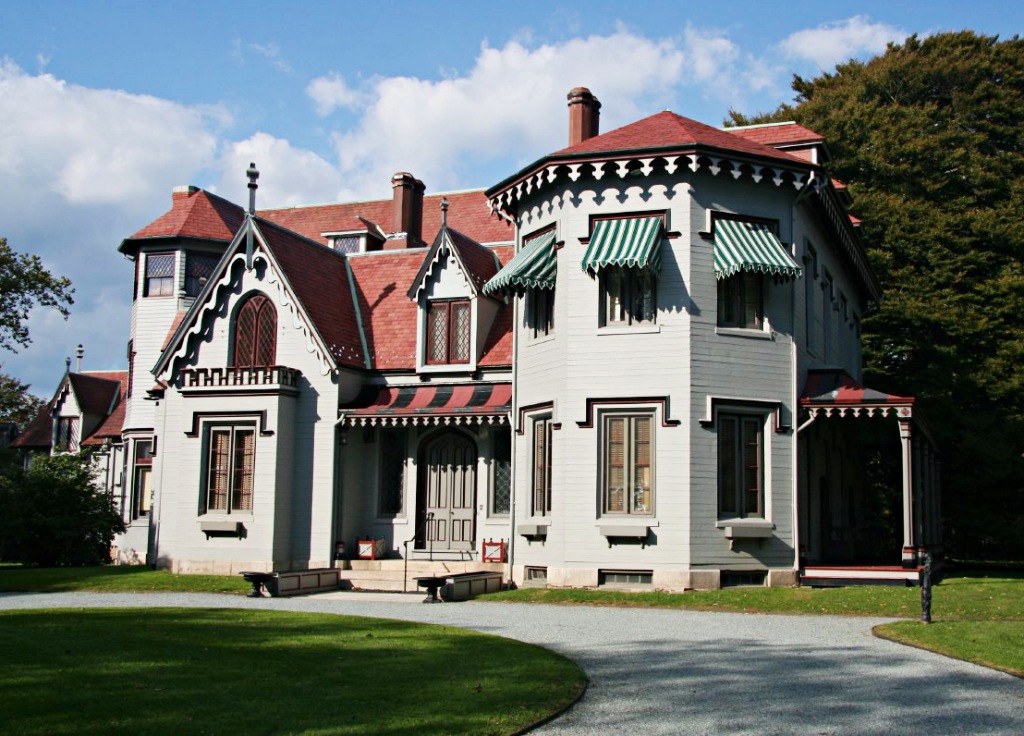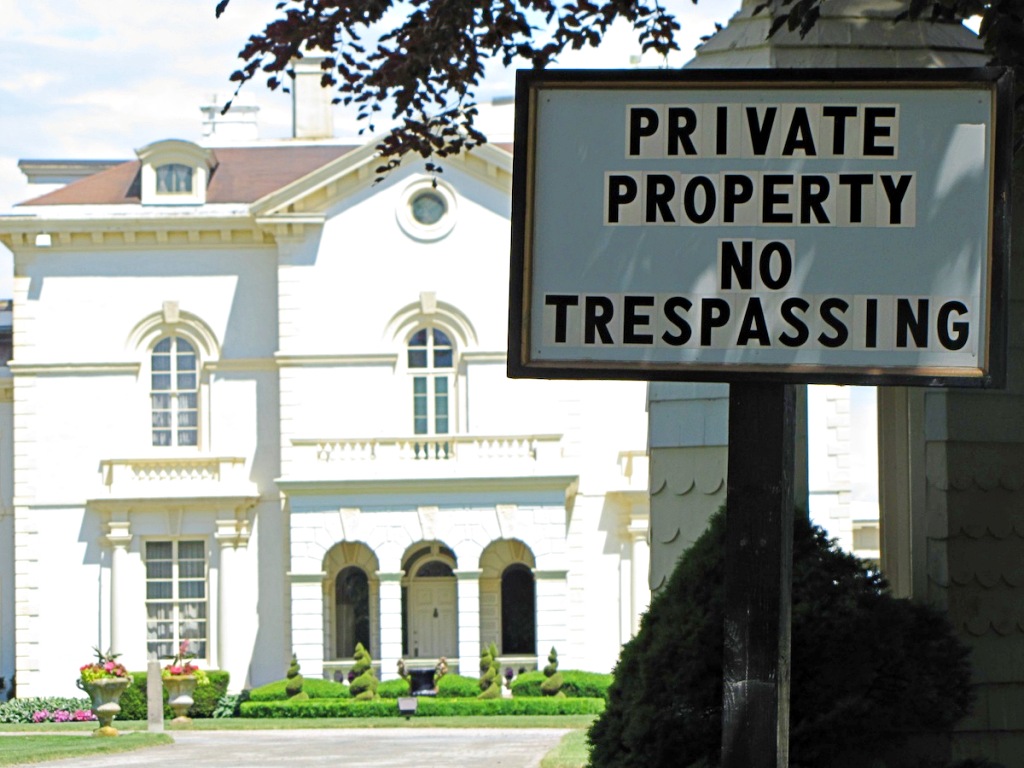Newport RI Mansions
Newport, Rhode Island, boasts mansions of two types these days: those that are museums open to the public, and those that are still private summer residences of the rich and famous.
The Breakers, grandest of Newport's grand mansions.
With many of Newport's most sumptuous, palatial mansions open to the public, you may think that Newport's Golden Age is long past.
Believe it or not, some of these palatial houses are still privately owned, maintained, and lived in.
Preservation Society
Through the efforts of the Preservation Society of Newport County, to which many of the mansion-owners belong, the marvelous houses we can tour today were preserved. It's astonishing to consider that The Elms, perhaps the most graceful and charming of all the mansions, was to be torn down to make way for a housing development before the Preservation Society purchased and preserved it.
The Society's Mansions
The Society maintains six grand Newport mansions, several historic houses, and Green Animals, America's first topiary garden, with 80 sculptured trees and shrubs, many in the shapes of animals.
Visiting the Mansions
When visiting the mansions, I advise these rules of thumb:
One Hour per Mansion
One hour is the minimum time for visiting one of the great houses. You'll need time to enter, join the tour, and take it all in, and perhaps walk in the grounds.
Up to 4 Mansions per Day
Don't try to see more than three or four houses in one day unless you have a tremendous capacity for absorbing glitter and magnificence. More than that in one day will leave you dizzy and exhausted.
Visit on Weekdays
Also, try to visit the mansions on a weekday, when the crowds are smaller, saving Saturday and Sunday for Newport's other attractions. If you must go on Saturday, get there early.
Wine & Food Festival
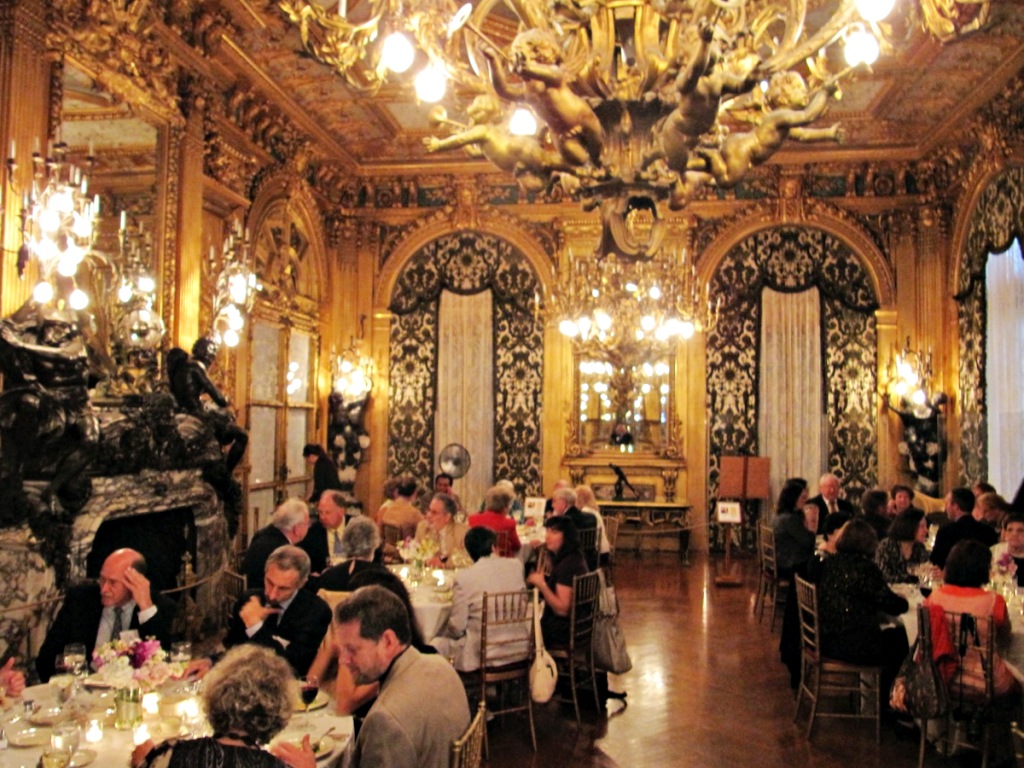
Gala dinner at Marble House...
For a special perspective on the mansions, participate in the Newport Mansions Wine & Food Festival, with cooking demonstrations by celebrity chefs, a variety of tastings and meals by local and regional restaurants, a Jazz Brunch and a lavish Meet the Chefs Gala. More...
The Holidays in Newport
Among the best times of year to visit the mansions is December, when admission lines are short or non-existant, and the mansions are decorated for the holidays with music and special programs.
At least three of the Preservation Society's mansions are open in the winter: The Breakers, Marble House, and one other (which may change from year to year).
Admission & Tours
A combination ticket for all of the Society's attractions can save you money. Tickets are on sale at all of the Society's mansions.
Admission to any mansion includes an informative guided tour through the rooms, and the right to stroll about the grounds at your leisure. Tours are frequent, and the guides are usually well informed.
The Breakers
The largest and most grandiose of Newport's mansions and most popular with visitors is The Breakers, 44 Ochre Point Avenue, an Italian Renaissance palace that is nothing short of sumptuous.
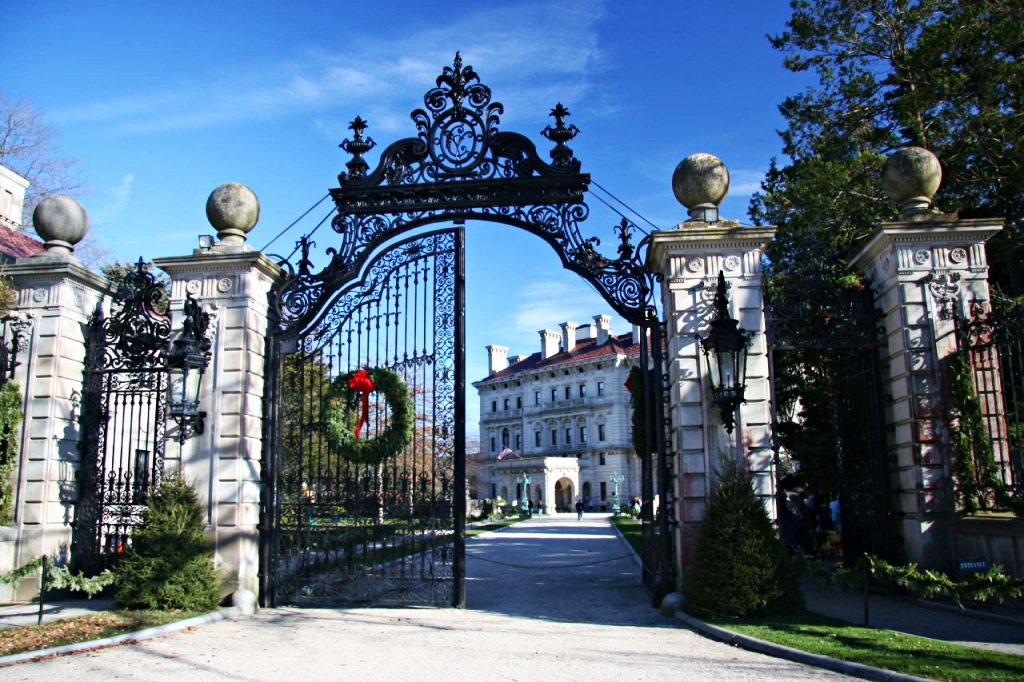
Grandest of Newport's
palatial mansions, The Breakers of
Cornelius Vanderbilt.
Designed by Richard Morris Hunt, who did a great many buildings in New England and particularly in Newport, The Breakers was commissioned in 1893 and built in only two years on a prime site off Belleveue Avenue with expansive sea views.
The original cost was something like $11 million, equivalent to hundreds of millions of dollars today.
Cornelius Vanderbilt called for the finest marble, and he got it. The marble columns in the two-story-high Great Hall have capitals carved of alabaster.
Priceless tapestries, fine mosaic work, irreplaceable paintings, and ornate furniture testify to the wealth of The Breakers' owners and their desire to flaunt it.
The Music Room was built and sumptuously decorated in pure gold by artists and artisans in France, then disassembled, shipped across the Atlantic Ocean, and reassembled here in Newport.
The huge classical columns in the grand Dining Room are made of pure alabaster.
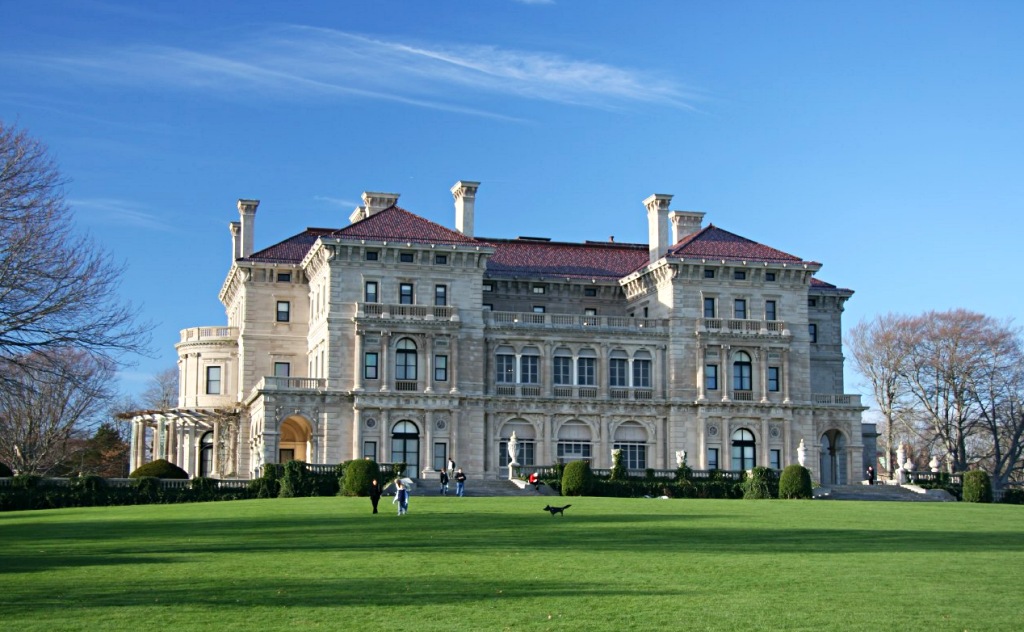
The Breakers, from Cliff Walk.
Believe it or not, my favorite time to visit The Breakers is...at the end of the year. Yes! The huge palazzo is sumptuously decorated with hundreds of poinsettias grown in the mansion's own greenhouses, and Victorian-style Christmas trees and wreaths. Performers fill the Great Hall with music, and you can wander at will, sip eggnog, and nibble Christmas cookies. No waiting in line to get in, either.
Besides the mansion, there is a children's cottage on the grounds built for the Vanderbilts' seven children. You may visit it as it is included in the price of admission to the mansion.
Stable & Carriage House
The Breakers' stable and carriage house, built to hold Vanderbilt's twenty luxurious coaches, with 28 stalls for fine horses and living quarters for twenty grooms, is a separate complex 6/10 of a mile (1 km, a 15-minute walk) west at 53 Coggeshall Avenue, corner of Bateman Avenue (map). The horses and grooms are gone, but the Preservation Society's collection of fine old coaches is on display.
Marble House
Modeled on the Grand Trianon at the Château de Versailles, Marble House is decorated in the style of Louis XIV, which was, well, grand. Very grand.
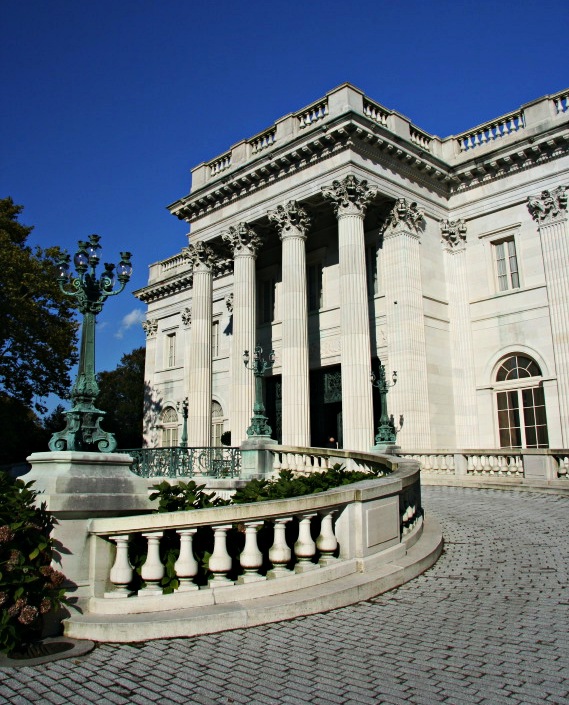
Marble House, a sparkling-white marble palace.
Richard Morris Hunt threw himself into building this mansion for William K Vanderbilt at 596 Bellevue Avenue and finished it in 1892. Vanderbilt gave it to his wife, Alma, as a little 39th birthday present.
At the time, it was the most sumptuous private residence in the USA. (The Breakers was completed in 1895.)
The architecture is classical, but the decoration is utterly French, that being the highest style at the time.
To the right after you enter is the Gold Room, a ballroom decorated with a king's ransom in gold. Room after room on two floors displays unbridled spare-no-expense luxury.
Most of the interior doors are transparent, made of heavy bevelled crystal panels. Chairs in the Dining Room are made of brass, and were so heavy that a footman was provided to each diner to help move the diner's chair.
As in The Breakers, the furnishings in Marble House are all original to the building; some have been restored.
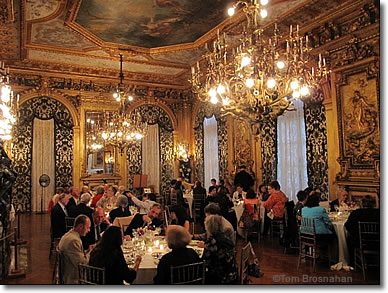
Gala dinner in the dining room at Marble House...
Besides the entertainment rooms, you'll visit the Vanderbilts' private rooms: boudoir, library, and bedrooms, as well as the kitchen and, across the lawn by the Cliff Walk, a fascinating oriental teahouse acquired in China and shipped to Newport.
Even the wall out front on Bellevue Avenue is made from sparkling white marble. The spear-like cast-iron pickets in the enclosure are tipped with gold.
One of the best times to visit Marble House is at the holidays, when it's decorated for the season in traditional Victorian style, and waiting lines to get in are short or non-existant.
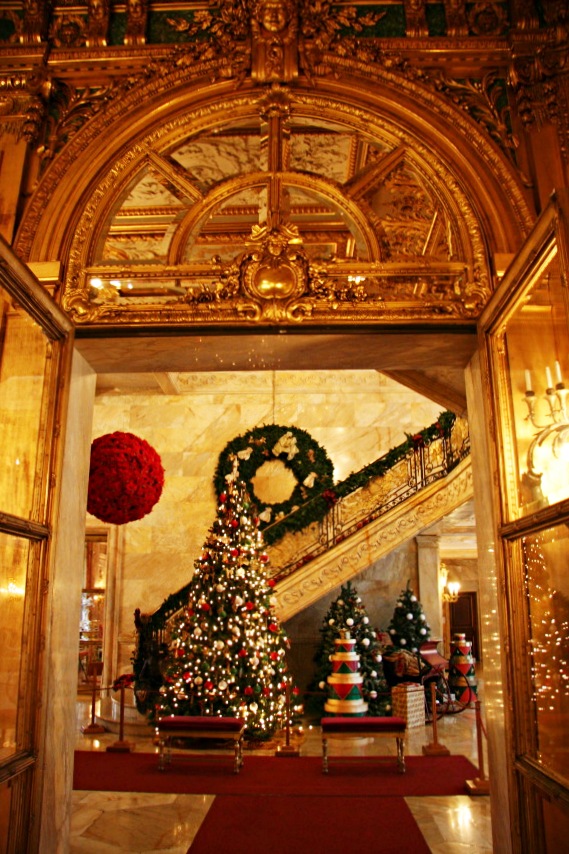
Holiday finery at Marble House.
Rosecliff
Rosecliff, 548 Bellevue Avenue, is modeled on the Grand Trianon at Versailles, but was meant to be even more lavish in layout and decor.
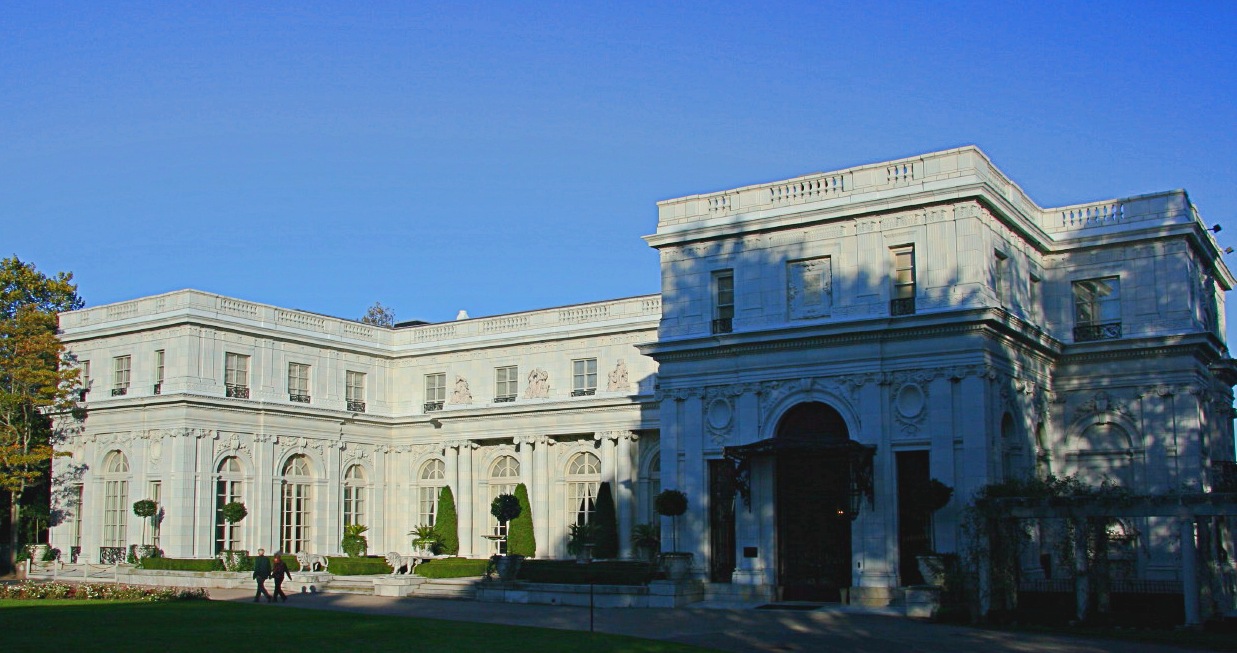
Rosecliff, on Bellevue Avenue in Newport RI.
Another famous New England architect, Stanford White, built Rosecliff between 1899 and 1902 for Theresa Fair Oelrichs, whose father had made a fortune in the silver mines of Nevada's Comstock Lode.
Miss Theresa Fair met Hermann Oelrichs in Newport, they married, bought the property that is now Rosecilff, and designed a house fit for the lavish entertainments they enjoyed.
The ballroom at Rosecliff is the largest in Newport. The mansion is still used for gala dinners and entertainments:
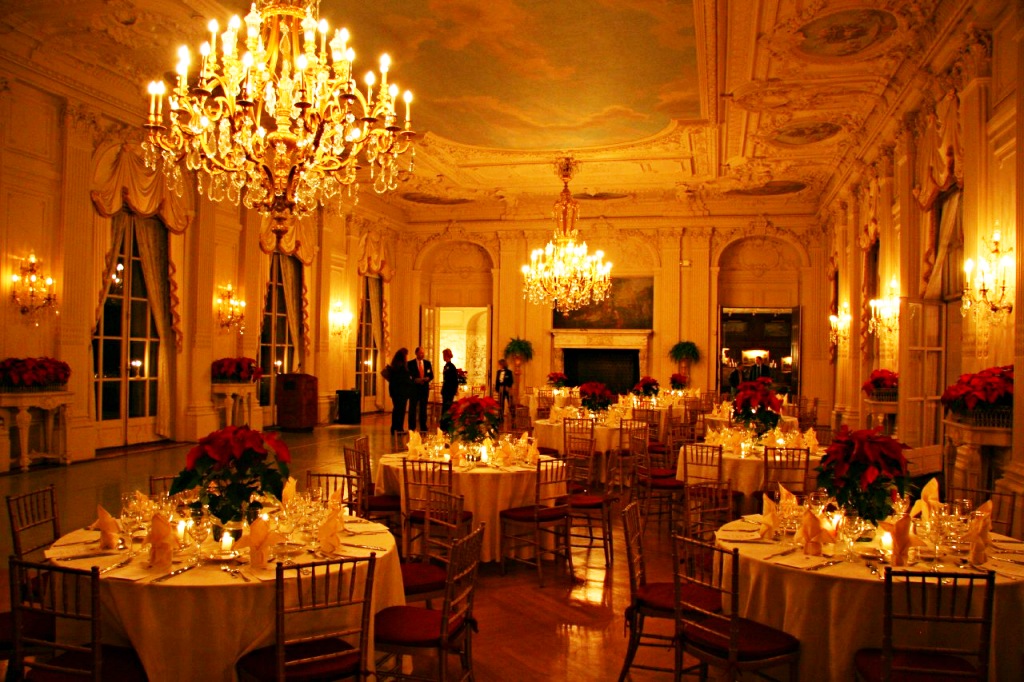
The ballroom at Rosecliff ready for a gala dinner...
In 1971 its last private owners, Mr & Mrs J Edgar Monroe, donated the house and all its furnishings to the Preservation Society of Newport County, which now cares for it.
Does Rosecliff look a little familiar? You may recognize it as one of the locations featured in the motion pictures 27 Dresses, Amistad, The Great Gatsby, and True Lies.
The Elms
Although E J Berwind's Newport mansion at 367 Bellevue Avenue is grand, it is also supremely harmonious, having been modeled on a chateau in France.

The Elms, perhaps the most beautiful and harmonious of Newport's palatial mansions.
E J Berwind, son of a Philadelphia tradesman, got an appointment to the US Naval Academy, and served in the Navy until mustered out with high rank because of an injury.
He joined his brother's coal company, built it into a huge business with its own mining companies, ships and railroads, and ultimately secured the contract to supply all US Navy ships with coal.
With the millions in profits he built The Elms, perhaps the most gracious and pleasant of the Newport mansions.
The Elms is a work of Philadelphia Gilded Age architect Horace Trumbauer (1868-1938), who designed many other immense private homes, as well as Harvard University's Widener Library and many of the buildings at Duke University.
Trumbauer's inspiration for The Elms was the 18th-century Chateau d'Asnières on the northern outskirts of Paris.
The sumptuous salons and chambers you can visit today were served by a staff of about 40, whose work and living quarters were hidden in the basement and top floors of the house. Mr & Mrs Berwind occupied the house for only six to eight weeks each summer, from mid-July through August.
The sunken formal garden beyond the little belvederes at the far end of the spacious lawn is not visible from the house. Designed by a French landscape architect, it comes as a pleasant surprise when you leave the house to explore the grounds.
The Elms was threatened with destruction in the 1960s when a land development firm bought it and planned to build a shopping center on the site. All of its precious furnishings were auctioned off, but a late intervention by the Preservation Society saved the house, and over the years many of the original furnishings have been reclaimed through purchase, donation or loan.
Chateau-sur-Mer
The first stone mansion to go up on Newport's Bellevue Avenue, at No. 474, Chateau-sur-Mer was built in 1852 for William S Wetmore, a China trade merchant of New York.
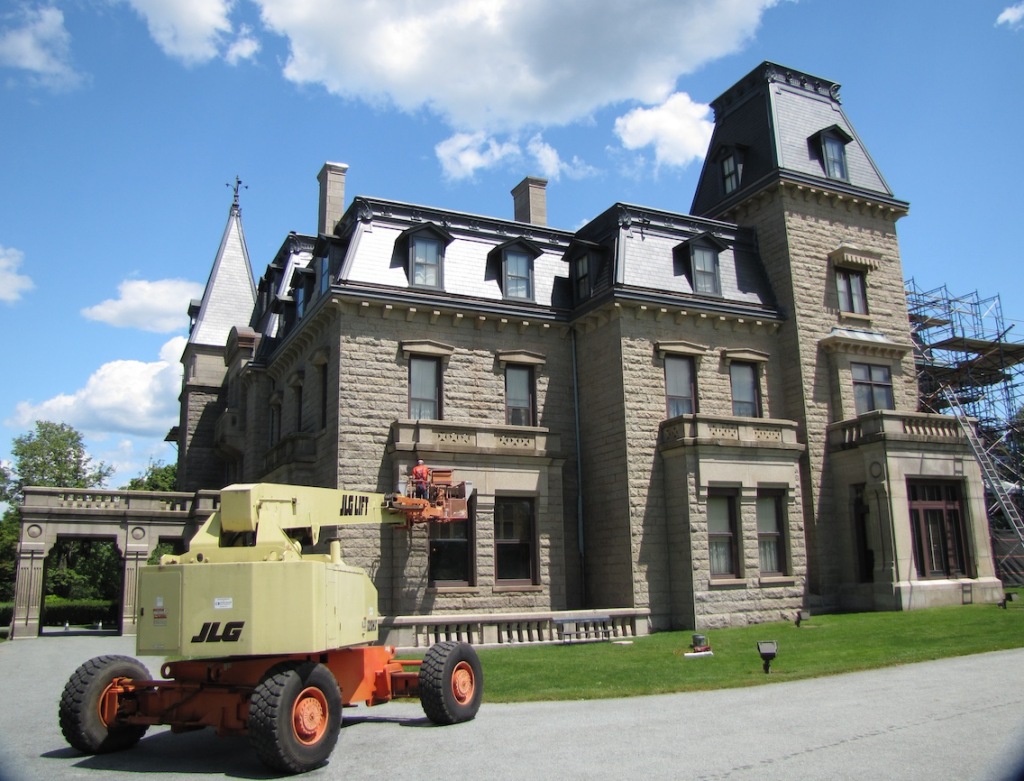
Chateau-sur-Mer at the time of renovations.
A triumph of High Victorian architecture, Chateau-sur-Mer was the grandest mansion in Newport from the time of its construction (1852) until the advent of the Vanderbilt mansions in 1892 and 1895.
Wetmore lived in the mansion for ten years, and upon his death in 1862, it was inherited by his teenaged children, son George and daughter Annie.
In 1870, George and Edith Wetmore left on an extended tour of Europe, leaving architect Richard Morris Hunt to redecorate the mansion in the Second Empire style popular at the time. Hunt went on to design and decorate several other grand Newport homes.
Chateau-sur-Mer has the feeling of being lived in and enjoyed—something that can't be said of some of some other mansions.
Kingscote
First built for plantation-owner George Noble Jones of Georgia by architect Richard Upjohn in 1839, Noble sold it and returned to the South at the beginning of the American Civil War.
The Gothic Revival mansion was bought by a merchant in the China trade called William H King, who gave the house its name.
A cottage it isn't, for no peasant lived here, but rather a man who appreciated Tiffany glass: the gorgeous dining room that he had designed by McKim, Mead and White of New York features special glass bricks made by Tiffany.
The King family owned the house until 1972, when it was deeded to the Preservation Society and soon therafter opened to the public.
Having been built originally in 1839 makes Kingscote one of the oldest of the Newport mansions.
Other Mansions
Rough Point
Rough Point, the English-manor-style stone mansion at 680 Bellevue Avenue, was the largest "summer cottage" in Newport RI when it was completed in 1887.
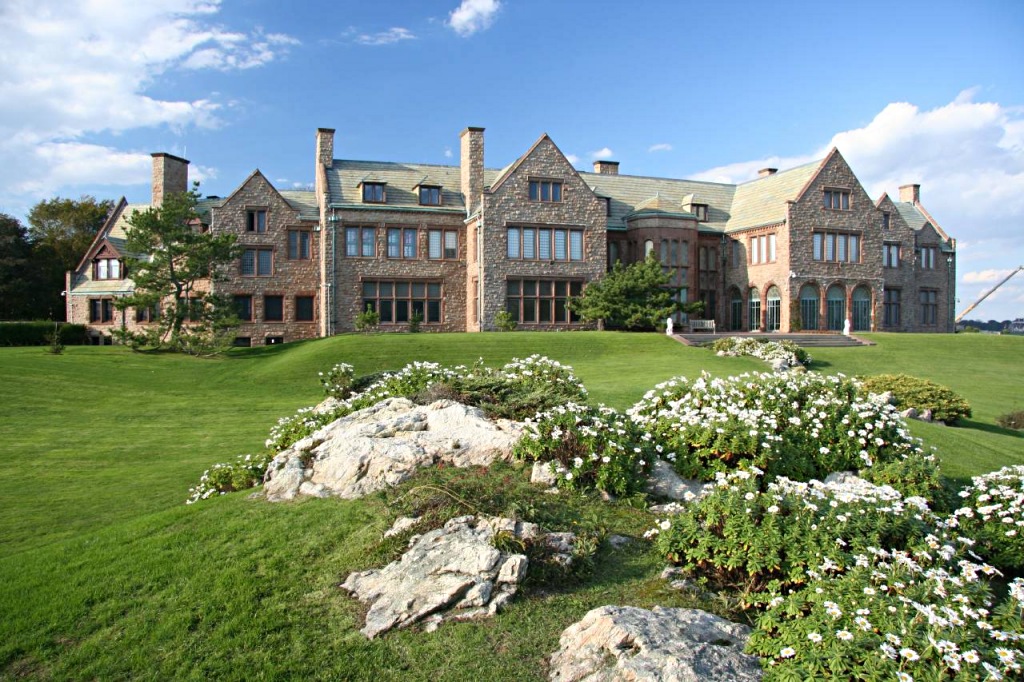
Rough Point, an odd name for the smooth life.
In a dramatic location at the southern end of Bellevue Avenue, its builder and first owner was Frederick W Vanderbilt, who sold it to William B Leeds in 1906. Leeds got to enjoy the house for only two years, dying in 1908.
James B Duke, driving force behind the automated cigarette-making machine, founder of the American Tobacco Company and Duke Energy, and benefactor of Duke University, bought the house in 1922.
Duke employed the landscape architecture firm of Frederick Law Olmsted to design the sprawling 2000-acre (809-hectare) estate's nine lakes, dozens of fountains and miles of roadways.
Duke died in 1925, having had little chance to enjoy the house. That pleasure fell to his daughter and only child, Doris Duke (1912-1993). Doris was presented to society at a debutante ball at Rough Point in 1930, and soon became famous as "the richest girl in the world."
Ms Duke led a glamorous, adventurous life on her various estates and on travels around the world. She married twice, created fabulous gardens, collected treasuries of art, supported important historic restoration efforts (particularly in Newport), and at her death bequeathed most of her fortune to charity.
Rough Point is now owned and administered by the Newport Restoration Foundation, which Ms Duke founded.
Vernon Court
This palatial mansion at 492 Bellevue Avenue is now the National Museum of American Illustration, with works by Maxfield Parrish and others.
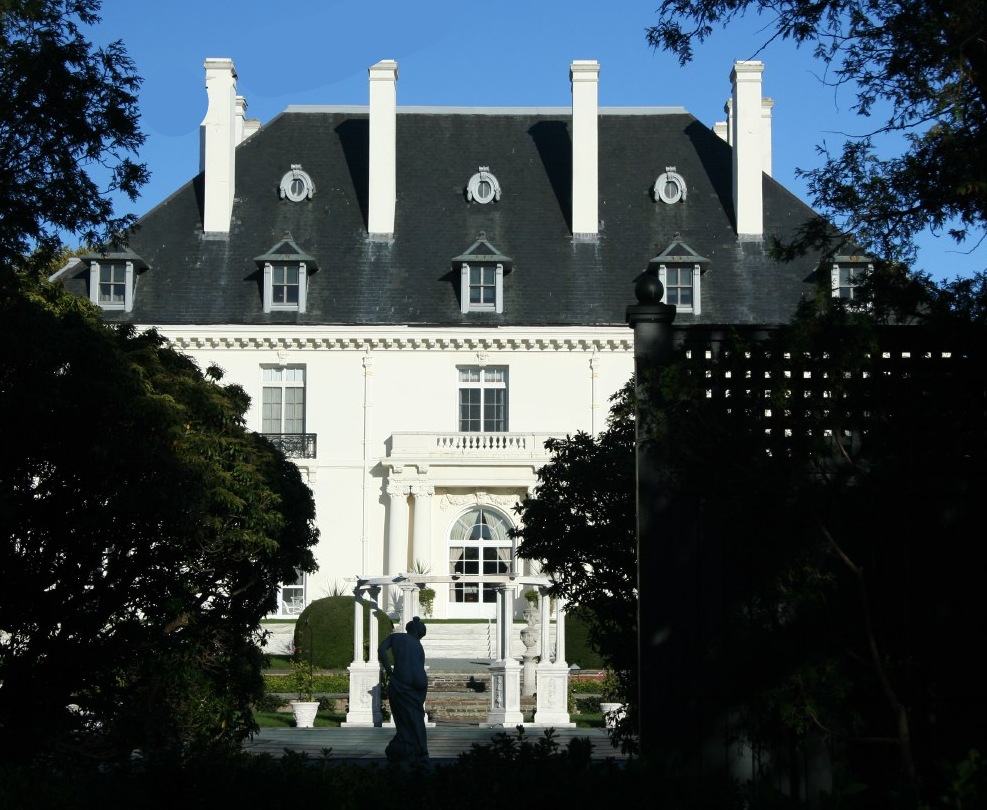
Vernon Court, now the home of the National Museum of American Illustration.
If you like the lively illustrations of Maxfield Parris, Norman Rockwell and Alberto Vargas, you'll love a visit to Vernon Court.
History
Anna Van Nest Gambrill (1865–1927), widow of New Jersey railroad magnate Richard A Gambrill, commissioned Carrère and Hastings to build a Newport "summer cottage"at 492 Bellevue Avenue (map) which she named Vernon Court.
Finished in 1898, the architecture was adapted from the Château de Haroué in Santois, Lorraine, France. The gardens were inspired by those at Hampton Court Palace in London.
Owned by the Gambrill family until 1956, it then had a succession of owners until 1972, when it was closed.
In 1998 it was purchased by Laurence S Cutler and Judy Goffman Cutler who, with the support of the National Arts Club, founded the National Museum of American Illustration,.
The Museum
The museum concentrates on the "Golden Age of American Illustration" from 1865 to 1945, after crude block printing gave way to engraved metal plate illustration, and before widespread news photography and television superceded the illustration art form.
The museum's collection now numbers more than 2300 works of art by over 100 artists including McClelland Barclay, H C Christy, John Clymer, Dean Cornwell, Steven Dohanos, Harvey Dunn, John Falter, Harrison Fisher, J M Flagg, Charles D Gibson, Phillip R Goodwin, Elizabeth S Green, Al Hirschfeld, W H D Koerner, John LaGatta, J C Leyendecker, Violet Oakley, Maxfield Parrish, Coles Phillips, Maurice Prendergast, Norman Price, Howard Pyle, Frederic Remington, Norman Rockwell, Mead Schaeffer, Frank E Schoonover, Alberto Vargas, Jessie Willcox Smith, Andrew Wyeth, Jamie Wyeth, N C Wyeth and others.
Stoneacre
Opposite Vernon Court, the three-acre (1.2-hectare) Stoneacre estate is named for the mansion built there in 1894, and razed in 1963. The grounds were designed by Frederick Law Olmsted as his first professional landscape-architecture commission, and the restored Frederick Law Olmsted Park is dedicated to the memory and career of Olmsted.
Isaac Bell House
This 1883 mansion at 73 Perry Street, was designed by McKim, Mead and White for Isaac Bell, a wealthy cotton broker and investor. It came into the Preservation Society's collection in 1994. Unlike most Society mansions, there is little furniture in the house—the manner in which the Society acquired it—the better to show off the house's distinctly American style of interior design and architecture.
Chepstow
Edmund Schermerhorn commissioned Newport architect George Champlin Mason to build him a summer home. Finished in 1860, this Italianate villa at 120 Naragansett Avenue changed hands in 1911 and was then owned by the Morris family until bequeathed to the Preservation Society in 1986.
The house still holds the furnishings from its time as a summer residence.
Hunter House
Among the fine Georgian-style colonial mansions surrounding Newport's Washington Square, the Hunter House at 54 Washington Street dates from 1748. Owned by wealthy merchants, it was abandoned by its Loyalist owners during the American Revolution, and then used by Admiral de Ternay, commander of the French fleet, when French forces occupied Newport in 1780.
The effort by concerned citizens to preserve Hunter House and its history was the impetus for the formation of the Preservation Society in 1945. Visit the house to see its fine colonial furniture and pewter, and paintings by Gilbert Stuart, Charles Bird King, and Cosmo Alexander.
Green Animals
In 1872, the Brayton family purchased this seven-acre estate at 380 Corys Lane, Portsmouth RI, overlooking Naragansett Bay and developed it into a self-sufficient farm with extensive gardens both decorative and practical. Beginning in 1912, the gardeners began shaping bushes into topiary (shrubs fashioned into shapes), including more than eighty animal shapes, suggesting the estate's name.
Besides the "green animals," the estate features many varieties of flowers—including more than 22,000 daffodils of all colors and varieties.
The estate, nine miles (14.5 km) north of Newport's Washington Square (map), was acquired by thre Preservation Society in 1972, and is open to visitors from mid-April through September.
Private Mansions
These mansions can only be admired from the street. They're privately owned, and not open to visitors.
The Astors' Beechwood
In the palatial Bellevue Avenue residence called Beechwood, members of the Astor family enjoyed their summers. Once open to visitors, Beechwood is now closed., a private residence again.

The house of William B Astor at 580 Bellevue Avenue was built in 1856. Beechwood was the family's "summer cottage" during the golden age of American tycoons.
In 2010, Beechwood was sold to a private party and is now private property not open to visitors.
William B Astor, son of John Jacob Astor, took over his father's real estate and tea businesses, and took advantage of the burgeoning city of New York, growing along with it.
When he died in 1875, Astor's holdings included more than a thousand properties in New York estimated to be worth at least $100 million (equal to about $13 billion today).
Belcourt Castle
Oliver Belmont and his wife, formerly Mrs William Vanderbilt, had Richard Morris Hunt design them a castle in the style of Louis XIII (1610-43). The palatial summer "cottage" at 657 Bellevue Avenue, finished in 1891, was then owned by the Tinney family, and later opened to the public, but in 2013 it was sold and is now private property, no longer open to visitors.
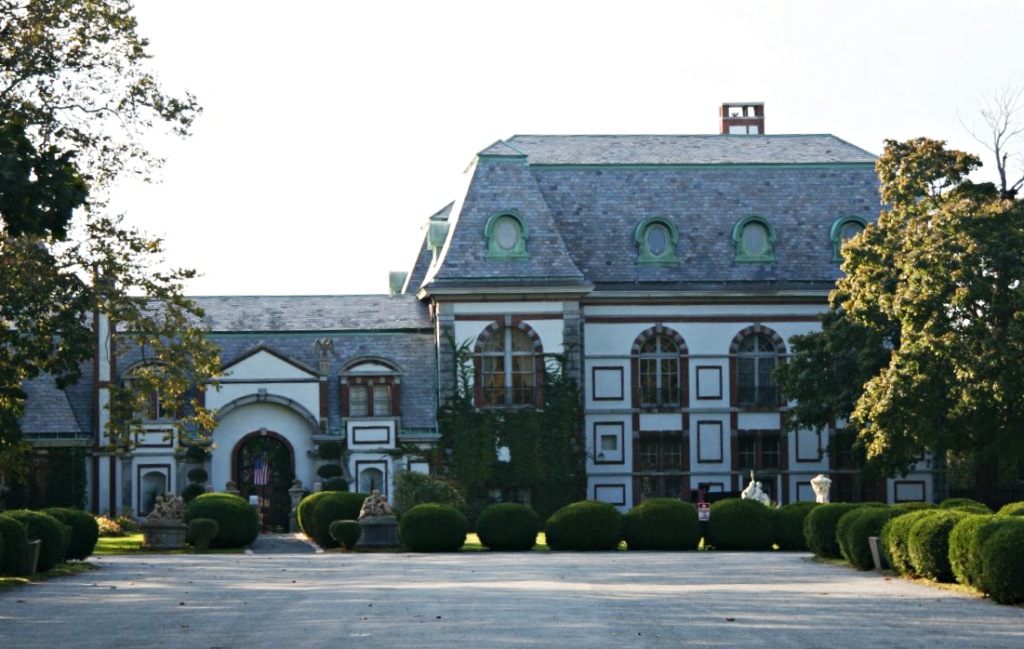
Belcourt Castle (1891).
Ochre Court
Ochre Court, a Loire-style château, is Newport's second-largest "summer cottage" after The Breakers.
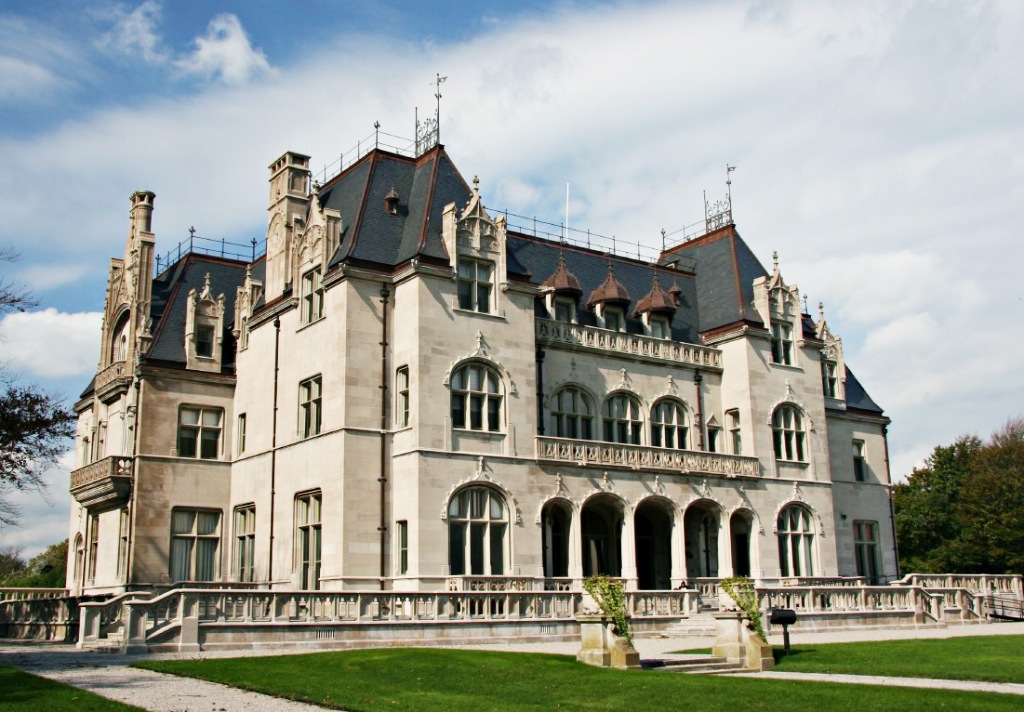
Ochre Court at Salve Regina University, Newport RI.
Designed by Richard Morris Hunt and built for Ogden Goelet in 1892, Ochre Court, 100 Ochre Point Avenue (off Bellevue Avenue) is styled after a French chateau, yet another example of Newport's architectural extravagance.
The mansion now serves as the administration building for Salve Regina University, having been given to the Catholic Religious Sisters of Mercy order in 1947.
As the Sisters vow to serve the poor, the sick and the uneducated, it's fitting that Ochre Court be used in the service of higher education, particularly that of women.
Ochre Court is private property, not open to the public (unless you have business with the university), although you can admire this Newport chateau from the street.
Hammersmith Farm
Hammersmith Farm was built by John W Auchincloss in 1887 as his family's 28-room "summer cottage."
After Jacqueline Bouvier, daughter of Mrs Hugh Auchincloss, became Mrs John F Kennedy, the wedding reception was held at Hammersmith Farm.
President Kennedy and the First Lady enjoyed visiting the farm when they could find the time, and no wonder: beautiful rolling lawns and gardens, nature paths and copses of trees—not to mention the lovely old house itself—make the farm a seaside paradise.
Mrs Auchincloss sold the Hammersmith Farm mansion in 1977, and it was opened to the public for awhile, but was later reclaimed as a private residence. Many of its original furnishings from the times when it figured prominently in the news have been sold off.
